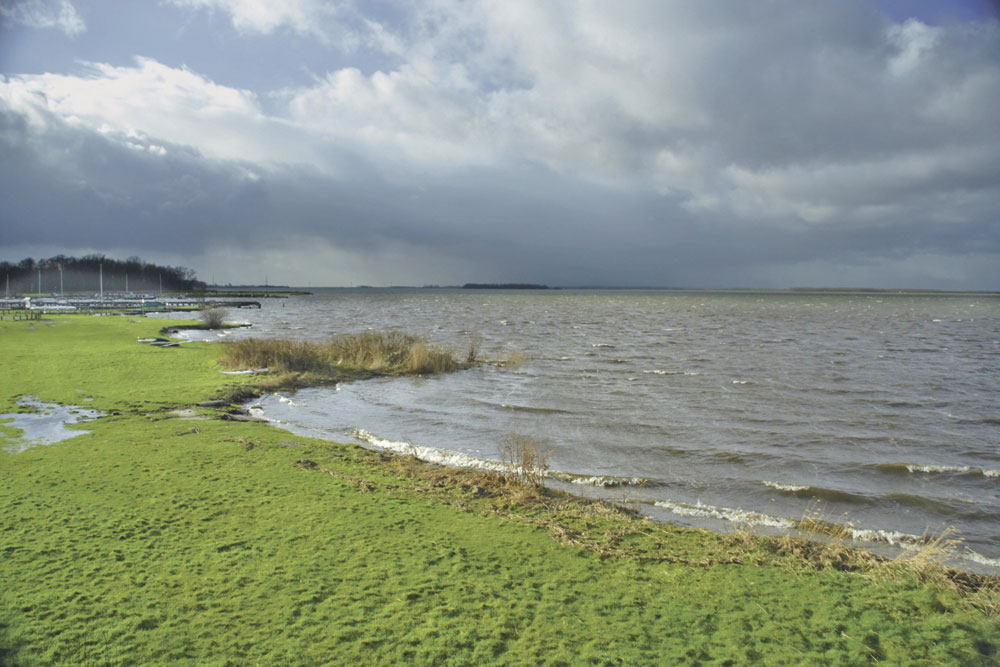Water in many of the large shallow Dutch lakes is turbid and of a colour between grey and green. But it’s not only algal bloom that mucks up our waters, discovered Dr Ellis Penning from Deltares.
Many lakes that were clear and transparent in the 1960s have lost their eco quality since then, owing to an overload of nitrates and phosphates dumped into the sewage and onto the fields. Algae began to dominate the waters, making them murky and too dark for water plants to survive in. Underwater deserts emerged unseen.
Primed by the European Water Framework Directive (WFD in 2000), water managers have taken to improving the ecological water quality. An obvious starting point is reducing the amount of ‘nutrients’ that flow into the surface waters. However, for many large shallow lakes, this measure has proven insufficient: the water is as opaque as before, suffocating any life at the bottom.
In her thesis, Dr. Ellis Penning shows that in large shallow lakes the water quality may be affected by wind and waves. Wind sweeping over the lake builds up waves that cause vibrating motions in the water, which may extend all the way to the bottom. The longer and shallower the lake, the stronger this effect will be. Depending on the type of soil, sediment may be picked up by the moving water and cloud the water.
“Light is essential for water plants to germ,” Penning explains. At least 4 percent of the light on the surface should reach the bottom, in order to give water plants a chance. Water plants in turn are essential for clear water: without them, sand and organic particles easily get picked up from the bottom and drift around, clouding the water. So, we have a vicious circle that is hard to break, in that an absence of plants results in murky waters in which no plants can take hold.
“Every lake is different,” Penning stresses. However, if reducing the concentration of nutrients doesn’t improve the ecological quality, wind-induced clouding may play a role. If it does – and a bottom sampling is required to be certain – wave breakers, local deepening or adding courser sand may bring the lake in closer compliance with the EU Directive.
Willemijntje Ellis Penning, ‘Ecohydraulics in large shallow lakes: implications for management’, PhD supervisor Prof. A.E. Mynett (CEG).
Twee andere Nederlandse projecten vallen in de prijzen: de 100-jarige erfgoedorganisatie Bond Heemschut in de categorie Dedicated Service en het architectuur & kunstproject ArtZuid in de categorie Education, Training and Awareness Raising.
Plácido Domingo, tevens President van Europa Nostra, zal samen met Androulla Vassiliou, EU-Commissaris voor Onderwijs, Cultuur, Meertaligheid en Jeugdzaken, op 10 juni in het Concertgebouw in Amsterdam deze prijzen uitreiken. Het is uitzondelijk dat er maar liefst drie Nederlandse winnaars van de European Union Prize for Cultural Heritage / Europa Nostra Awards tussen de 27 winnaars uit 13 landen zitten. Tijdens de ceremonie zullen 6 van de 27 winnende projecten een hoofdprijs ontvangen. Of Nederland daar bij zit wordt pas op 10 juni bekendgemaakt.
De 27 winnaars zijn gekozen uit bijna 140 projecten uit 31 landen. De uiteindelijke keuze is gemaakt door een jury van onafhankelijke deskundigen uit heel Europa. De 6 winnaars van de hoofdprijs ontvangen elk 10 000 euro en een gedenkplaat (als het om een gebouw gaat) of een trofee (als het om een project gaat).
Overzicht van alle winnaars op www.europanostra.org



Comments are closed.